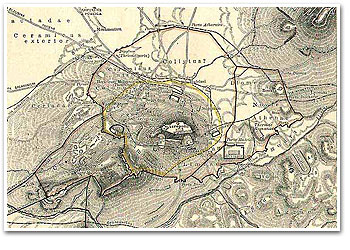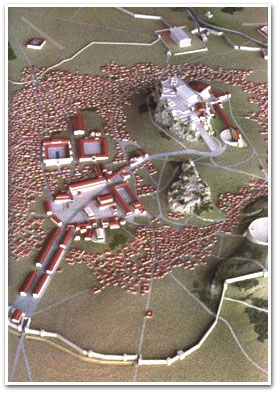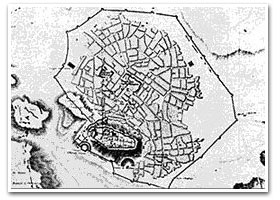
The ancient city formation
Over the course of the centuries, Athens was rebuilt time and time again on the same site as it was forced to expand within a restricted area around the ancient walls of Themistocles (see the hypothetical position of the walls in the map). This is exactly where the true historical centre of Athens is situated, that is the area of the city that has been inhabited for more than 7000 years.Following is the lay out of Athens during the Hellenistic and Roman periods, at the time of the city's greatest splendour:
 * in the south: were housed the temples and monuments;
* in the south: were housed the temples and monuments;
* outside the walls in the northwest: were the Academy of Plato, the ancient cemetery and the various commercial, institutional and craft areas;
* in the northwest: The Academy of Plato, the ancient cemetery and the various commercial, institutional and craft (like The Agor�);
* in the northeast: were the residential areas of the city;
Today in the southern part, where the Acropolis, the Areo Pago, the Nymphs and the Filoppapou hills are situated and where the inhabitants of Athens once built their great temples and theatres, lies the archaeological park. It incorporates all the city's most important monuments.
The northern area has always been for residential and commercial purposes, today it houses the ancient quarters that are an interesting testimony of both the ancient past and the most recent past, between the X and the XIX centuries.
 The only area that has been inhabited uninterruptedly throughout the centuries, is the one with the quarters of Plaka,
Anafiotika, Monastiraki, Psir� and the Acropolis. Even when Athens was conquered by the Byzantine and Ottoman Empires,
this area continued to be inhabited, despite the decline of the Hellenic splendour and the subsequent centuries of oppression and decay.
The only area that has been inhabited uninterruptedly throughout the centuries, is the one with the quarters of Plaka,
Anafiotika, Monastiraki, Psir� and the Acropolis. Even when Athens was conquered by the Byzantine and Ottoman Empires,
this area continued to be inhabited, despite the decline of the Hellenic splendour and the subsequent centuries of oppression and decay.
In fact for more than one thousand years, Athens not only ceased to become a capital city, but was reduced to a small village huddled on the northern part of the Acropolis hill, while its ancient monumental areas were being used by the invaders as forts, headquarters and arms storage. This is why Athens, except for the tiny wonderful Byzantine churches, holds little evidence of its medieval history and also why the city could only re-flourish in the 19th century, once it had become independent and once again the capital of Greece.